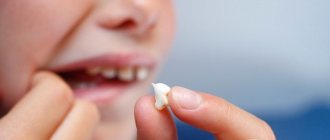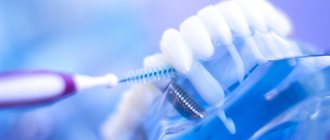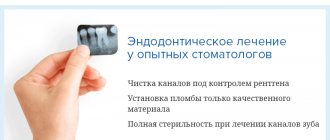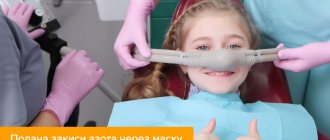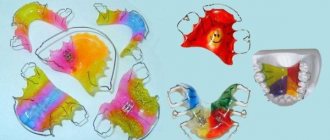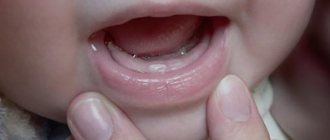What are baby teeth?
A child may believe that baby teeth are needed only so that the Tooth Fairy has something to build her snow-white castle from. But adults should know the truth. When a child is still very small, his head, and therefore his jaw, are small. If the baby, instead of milk teeth, began to cut molars immediately, they would not fit into the mouth either in size or in number. Therefore, nature gave us a temporary solution for the first ten years.
There are 20 primary teeth in total (10 each on the upper and lower jaws). These are incisors - central and lateral, canines, and molars. Usually, a child already has all of them at the age of 3-3.5 years.
Milk teeth differ from primary teeth not only in size, but also in structure. The enamel of primary teeth is approximately 2 times thinner and not as rich in minerals. Therefore, the child needs to carefully monitor oral hygiene - caries on baby teeth develops very quickly. Milk teeth have thin not only enamel, but also the layer underneath it - dentin - so caries quickly develops into pulpitis. Baby teeth have both nerves and roots, but they are shorter than molars. The latter gradually “dissolve” during the period of change of bite. This is why the teeth begin to loosen.
If baby teeth are not taken care of and treated, the child’s gums may become inflamed, and the embryos of the molars may suffer or die. Don't leave caries unattended!
What causes baby teeth to fall out?
Before permanent teeth appear, interesting physiological changes occur, such as the spontaneous resorption of the roots of baby teeth. This is why they begin to wobble and fall out. The germs of permanent teeth are located between the roots of milk teeth, because of this, resorption begins from the place where the root adheres to the germ of a permanent tooth. Resorption starts from the apex of the root and gradually moves towards its base. As soon as this process approaches the neck, the tooth falls out.
Children erupt 20 baby teeth. In the oral cavity, adults have from 28 to 32 teeth. Typically, all baby teeth fall out. In a child by the age of 14, they should be completely replaced by permanent ones.
How and when do teeth change?
Loss of primary teeth begins at approximately 6-7 years of age and usually lasts until 10-12 years of age. Note that girls say goodbye to temporary teeth earlier than boys and the replacement process itself is more dynamic for them.
Parents will be able to guess that their child’s baby teeth are about to change due to a number of factors: due to jaw growth, the distance between the incisors will increase, the rudiments of molars become visible under the baby teeth, and the primary teeth become loose.
On average, the age at which a child changes teeth corresponds to the years given in the tables below:
Order of loss of baby teeth
| Age | What teeth fall out |
| 6-7 years | Central incisors fall out |
| 7-8 years | Lateral incisors fall out |
| 9-11 years | The child loses his first molars |
| 10-12 | Canines and second molars fall out |
⠀
Please note that the new tooth may not be in a hurry to take the place of the fallen one. If a couple of weeks or even more than a month have passed and there is still no molar, this is not a reason to panic. Also keep in mind that there are more molars, so some take their place without changing their predecessors. For example, molars or (the first permanent molars), erupt from scratch at the age of 5-7 years - they should not be confused with milk teeth.
Growth of molars
Molars are called a little differently than baby teeth. Try not to get confused:
| Molar | Age of appearance | Which milk tooth replaces |
| Central incisors | 6-8 years | Central incisors |
| Lateral incisors | 7-9 years | Lateral incisors |
| Fangs | 10-13 years | Fangs |
| First premolars | 9-12 years | First molar |
| Second premolars | 10-13 years | Second molar |
| First molars | 5-7 years | Do not replace baby teeth |
| Second molars | 11-14 years old | Do not replace baby teeth |
| Third molars | 17-25 years old | Do not replace baby teeth |
⠀
If you do not take into account the third molars (which are also called wisdom teeth), girls receive a fully formed jaw by 11-13 years, and boys by 13-14 years.
It is important to understand that the baby tooth may not be replaced. For example, if the germ of a molar tooth has died, then nothing pushes the temporary tooth to leave the mouth. People live with partial milk teeth even into their 30s. Therefore, if a baby tooth does not fall out, you should not try to loosen it or try to pull it out at home. Below we will look at other problems when changing teeth.
In what order do teeth change?
As soon as baby teeth fall out, permanent teeth erupt at the same time. There is a close relationship between these two processes. They appear in the same order as they fall out: first, the incisors change, then the first and second premolars, and then the turn comes to the canines.
- The eruption of the first molars (sixth teeth) occurs long before the process of changing teeth; they are immediately permanent.
- Second molars begin to grow in the spaces created by jaw growth.
- In many people, “wisdom teeth” or third molars may not grow at all, or their eruption is very problematic.
Deviations in timing and problems when changing teeth
One or another problem with the loss of baby teeth and the germination of molars occurs in at least every tenth child. Fortunately, dentists are ready to correct the bite during the growth stage, remove extra teeth, and even insert an implant if there is no point in waiting for a root one.
Let's look at the main deviations that may cause concern:
"Shark's Mouth"
Sometimes baby teeth do not have time to fall out, but the molars have already grown “second row”. The “shark’s mouth” is not worth admiring. You need to go to the dentist as soon as possible and remove unnecessary temporary teeth, otherwise your bite may be significantly damaged.
Untimely change of teeth
If the first baby teeth begin to leave the baby’s mouth before 5 years of age or after 8 years of age, then this is a deviation from the norm, which means you need to understand the reason. Trauma, caries, ecology, nutrition, congenital problems with bite or other heredity, various infectious diseases, hormonal problems (for example, thyroid disease), as well as diseases due to which the child is at risk for underdevelopment and delay may be to blame. formation of permanent dentition (diabetes, leukemia, immunodeficiency and others).
The molar does not grow in place of the lost milk tooth
There is no need to panic, but it is worth consulting with a specialist. For example, if a molar tooth does not erupt, although the baby tooth has fallen out a long time ago, the reason cannot be determined with ordinary eyes, but an x-ray will help. If there is no tooth germ in the picture, this is called adentia. This problem is extremely rare - the tooth simply has nothing to grow from. The decision will require the help of a prosthetist.
With retention, the germ of a new tooth is present, but it is directed incorrectly or is deep in the gum. All that remains is to wait for the tooth to grow. This problem occurs more often in the lower third molars, as well as in the upper incisors and canines.
With impaction, the tooth cannot come out due to the close fit of neighboring teeth. Here, too, you cannot do without the help of professionals.
We also advise you to consult a doctor if:
- molars appear darkened or grow crooked;
- the order of tooth loss and growth differs significantly from the above graphs;
- the child’s gums hurt and his cheek is swollen;
- baby tooth is corroded by caries;
- a tooth fell out, but blood from the socket does not stop oozing for more than an hour (not to be confused with ichor).
Scientists go their own way in restoring teeth
Despite the fact that under special conditions a person is able not only to grow new teeth, but even to restore a lost leg or arm, not to mention internal organs, scientists are accustomed to approaching any problem not from the inside, but from the outside (they always get into house through the window). That is why today they are intensively looking not for opportunities to “wake up the human body,” but for methods of artificially restoring lost teeth. The most promising in this direction seems to be the theory of restoring a gene lost by a person, which is responsible for the formation and constant maintenance of normal gums and teeth.
There are other directions too. However, before all these discoveries are implemented in practice, and even more so in full-scale implementation at the level of the entire planet, as they say, the distance is enormous, if that is even possible. Current generations are unlikely to be able to take advantage of the achievements of science in order to remain with strong and beautiful teeth until their death. Therefore, if you want to restore your teeth, then remember that in our world, saving a drowning person is always the job of the drowning person himself. You shouldn’t rely too much on science...
Video: To make your teeth grow a third time
Wanted and grew new teeth
Mikhail Stolbov lost his teeth in the army in the late seventies of the last century. They were simply knocked out for him, since at that time hazing flourished in the Armed Forces of the USSR - real criminal lawlessness (very indicative in this case is the story of the world-famous healer and spiritual leader M. Norbekov, to whom in the army, at approximately the same time, old-timers completely The kidneys were knocked out, but he later restored them - read his biography).
While still in the army, Stolbov was given cheap dentures instead of his natural teeth, and he lived with them, replacing them whenever possible with better ones, but he never managed to get used to them. He was especially depressed by the tongue-tiedness that appeared for this reason. One day, by the will of fate, Mikhail found himself in the remote taiga. And at this time his gums hurt, so much so that he was forced to give up dentures and completely switch to ground and porridge-like food. The pain served as a huge incentive for him to search for how to restore lost teeth. This obsession eventually resulted in Stolbov having most of his teeth restored. This was a real miracle, but this fact is documented in medical practice.
Mikhail himself later wrote that first you need to believe in this miracle, then switch to a healthy lifestyle and diet (in this case, living in the taiga, far from civilization, helped him), because without accumulating the necessary energy in the body, nothing will come of it. And then you should learn to hear your body and try to see and feel how your teeth grow.
Remember when your teeth grew as a child?
Oryol writer and yogi Sergei Veretennikov believes that only with the power of thought can you launch a dental growth program in your body. And to do this, you first need to remember all the sensations that you experienced in early childhood when your teeth were growing. This is the first and most important button we press. The second button is to concentrate attention on the two lower front incisors, which are the first to grow in a person in childhood. And the third button - concentration of attention on the point between the eyebrows (on the third eye) with the thought - I am growing new teeth. And if you keep these buttons “on” most of the day, success is guaranteed.
The main enemies in this process are unbelief (by faith, what will be given to you) and fear, especially the fear that the new teeth will somehow interfere with the remaining ones (they will not interfere, it has been proven in practice). But the most insidious enemy is still human laziness, and not only in the matter of restoring teeth. It is she who forces us to resort to the services of doctors, although our most important healer is ourselves...
Is it possible to pull out a baby tooth yourself?
At home, you can remove a baby tooth only if it is well loosened and you can walk freely in the socket.
It is important that the child does not have a cold: coughing, sneezing, runny nose - these are stop signals for home removal of a baby tooth. Examine the child’s mouth - if there is swelling or bleeding of the gums, your manipulations may lead to infection in the socket. It's better to see a dentist.
If you still decide to pull out a baby tooth, it is better not to experiment with tying the object to be removed to the door handle.
The best way is this: wrap the tooth with gauze soaked in alcohol and pull it out of the hole until it comes out. The tooth can also be wrapped with sterile thread and pulled strictly perpendicular to the jaw.
After the manipulations are successful, the child needs to rinse his mouth, the parent needs to see if there are any parts of the tooth left in the socket (if the tooth is broken and something remains, you need to go to the doctor). Sterile cotton wool is placed in the hole for 20 minutes: the child must press it with his teeth to stop the bleeding. Make sure your child does not drink or eat for a couple of hours after tooth extraction.
If the tooth falls out on its own, also put cotton wool in the hole and do not let the baby drink or eat for a while.
What not to do?
The following rules will help you avoid bite problems and the appearance of various defects:
- do not allow your child to loosen his teeth if they are not yet going to fall out and are firmly in place;
- teach your child not to touch a loose tooth with dirty hands (and, of course, he should not pick the hole when the tooth has just fallen out);
- Do not give your child a lot of solid foods during the period of bite changes. This way he can break a baby tooth;
- do not fill the hole after tooth loss with alcohol;
- You shouldn’t make fun of your child’s temporary toothlessness.
Where to put baby teeth after they fall out?
The first tooth can be kept as a souvenir or given to the child to put in a box with children's valuables. If sentimentality is not accepted in your family, then the tooth can be thrown out.
In many families, the tooth is placed under the pillow to be taken away in exchange for a coin or small treat by the Tooth Fairy. This character came to us from the West. The fairy builds a castle from children's teeth in which good dreams are born.
But there is also a domestic tradition - to give a lost tooth to a mouse, which can also thank you with a gift. Previously, the tooth was thrown underground or hidden behind the stove with the words “Here, mouse, a bast tooth! Give me a bone one, mouse!” Now this story is more suitable for residents of private houses. It's up to you to decide whether it's worth chasing a mouse into an apartment on the 20th floor, even if it's a fabulous one. But you can take absolutely any magical character that your child likes and come up with a story about where and why the baby’s tooth will end up.
Interesting fact: baby teeth contain both stem and progenitor cells. Scientists believe that in the future, with the development of science and technology, baby teeth can be used for the benefit of their owners, for example, to treat serious diseases. But in order to preserve the cells in the tooth, special storage conditions are required, which, unfortunately, cannot be created at home.
Technology of growing teeth from stem cells
The last 30 years in biology and medicine can safely be called a boom in the study of stem cells. These cells attract the attention of scientists for the simple reason that they can become a source of youth, and, according to the most daring forecasts, immortality.
Stem cells are undifferentiated. During their life, they can transform into any other specialized cell. In an adult, the stem cell reserve is limited. At some point, there are critically few of them, which does not allow organs and systems to maintain the same level of functionality. Therefore, it is believed that stem cell procedures can rejuvenate the body.
The most interesting quality of stem cells is their ability to specialize into other cells. This opens the way for scientists to grow tissues and organs. Relatively speaking, you can take a certain number of stem cells from a patient, multiply them in the laboratory, and then, using special stimulants and conditions, force these cells to transform, for example, into cells of the heart, liver, kidneys, muscles, and so on. To do this, an organ frame is initially created, onto which stem cells are applied using a bioprinter (where cells are used instead of ink). Theoretically, growing a tooth is possible using this technology. Today, American, British, Japanese and Chinese researchers are working closely on this.
So far, the external method of growing teeth (outside the body) seems difficult. For this reason, scientists are focused on the technique of implanting tooth germs into the jaw (an internal method of growing teeth). This will allow you to achieve a second change of teeth, and then a third (if necessary).
As mentioned above, germ cells of teeth taken from embryos are used for these purposes. As you might guess, such a procedure is impossible in humans for ethical reasons. Therefore, scientists propose using stem cells that can be “trained” so that they turn into rudimentary dental cells. And these cells are already planted in the jaw. This technique has been tested more than once on animals. Let us note that such research progresses every year, and teeth grown in this way are getting closer in their characteristics to natural teeth.
